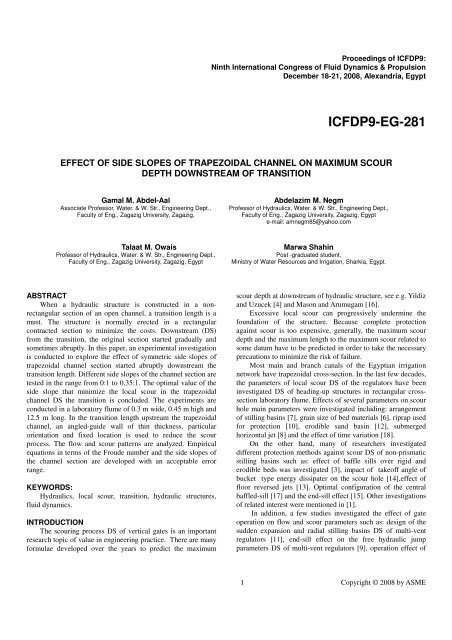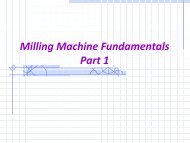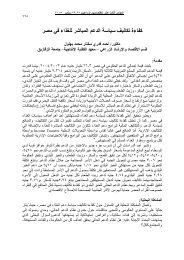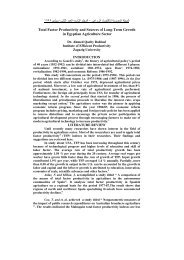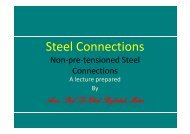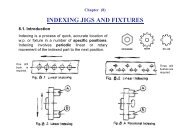ICFDP9-EG-281 - Zagazig University Staff Home Page
ICFDP9-EG-281 - Zagazig University Staff Home Page
ICFDP9-EG-281 - Zagazig University Staff Home Page
Create successful ePaper yourself
Turn your PDF publications into a flip-book with our unique Google optimized e-Paper software.
Proceedings of <strong>ICFDP9</strong>:<br />
Ninth International Congress of Fluid Dynamics & Propulsion<br />
December 18-21, 2008, Alexandria, Egypt<br />
<strong>ICFDP9</strong>-<strong>EG</strong>-<strong>281</strong><br />
EFFECT OF SIDE SLOPES OF TRAPEZOIDAL CHANNEL ON MAXIMUM SCOUR<br />
DEPTH DOWNSTREAM OF TRANSITION<br />
Gamal M. Abdel-Aal<br />
Associate Professor, Water. & W. Str., Engineering Dept.,<br />
Faculty of Eng., <strong>Zagazig</strong> <strong>University</strong>, <strong>Zagazig</strong>,<br />
Abdelazim M. Negm<br />
Professor of Hydraulics, Water. & W. Str., Engineering Dept.,<br />
Faculty of Eng., <strong>Zagazig</strong> <strong>University</strong>, <strong>Zagazig</strong>, Egypt<br />
e-mail: amnegm85@yahoo.com<br />
Talaat M. Owais<br />
Professor of Hydraulics, Water. & W. Str., Engineering Dept.,<br />
Faculty of Eng., <strong>Zagazig</strong> <strong>University</strong>, <strong>Zagazig</strong>, Egypt<br />
Marwa Shahin<br />
Post -graduated student,<br />
Ministry of Water Resources and Irrigation, Sharkia, Egypt.<br />
ABSTRACT<br />
When a hydraulic structure is constructed in a nonrectangular<br />
section of an open channel, a transition length is a<br />
must. The structure is normally erected in a rectangular<br />
contracted section to minimize the costs. Downstream (DS)<br />
from the transition, the original section started gradually and<br />
sometimes abruptly. In this paper, an experimental investigation<br />
is conducted to explore the effect of symmetric side slopes of<br />
trapezoidal channel section started abruptly downstream the<br />
transition length. Different side slopes of the channel section are<br />
tested in the range from 0:1 to 0.35:1. The optimal value of the<br />
side slope that minimize the local scour in the trapezoidal<br />
channel DS the transition is concluded. The experiments are<br />
conducted in a laboratory flume of 0.3 m wide, 0.45 m high and<br />
12.5 m long. In the transition length upstream the trapezoidal<br />
channel, an angled-guide wall of thin thickness, particular<br />
orientation and fixed location is used to reduce the scour<br />
process. The flow and scour patterns are analyzed. Empirical<br />
equations in terms of the Froude number and the side slopes of<br />
the channel section are developed with an acceptable error<br />
range.<br />
KEYWORDS:<br />
Hydraulics, local scour, transition, hydraulic structures,<br />
fluid dynamics.<br />
INTRODUCTION<br />
The scouring process DS of vertical gates is an important<br />
research topic of value in engineering practice. There are many<br />
formulae developed over the years to predict the maximum<br />
scour depth at downstream of hydraulic structure, see e.g. Yildiz<br />
and Uzucek [4] and Mason and Arumugam [16].<br />
Excessive local scour can progressively undermine the<br />
foundation of the structure. Because complete protection<br />
against scour is too expensive, generally, the maximum scour<br />
depth and the maximum length to the maximum scour related to<br />
some datum have to be predicted in order to take the necessary<br />
precautions to minimize the risk of failure.<br />
Most main and branch canals of the Egyptian irrigation<br />
network have trapezoidal cross-section. In the last few decades,<br />
the parameters of local scour DS of the regulators have been<br />
investigated DS of heading-up structures in rectangular crosssection<br />
laboratory flume. Effects of several parameters on scour<br />
hole main parameters were investigated including: arrangement<br />
of stilling basins [7], grain size of bed materials [6], riprap used<br />
for protection [10], erodible sand basin [12], submerged<br />
horizontal jet [8] and the effect of time variation [18].<br />
On the other hand, many of researchers investigated<br />
different protection methods against scour DS of non-prismatic<br />
stilling basins such as: effect of baffle sills over rigid and<br />
erodible beds was investigated [3], impact of takeoff angle of<br />
bucket type energy dissipater on the scour hole [14],effect of<br />
floor reversed jets [13]. Optimal configuration of the central<br />
baffled-sill [17] and the end-sill effect [15]. Other investigations<br />
of related interest were mentioned in [1].<br />
In addition, a few studies investigated the effect of gate<br />
operation on flow and scour parameters such as: design of the<br />
sudden expansion and radial stilling basins DS of multi-vent<br />
regulators [11], end-sill effect on the free hydraulic jump<br />
parameters DS of multi-vent regulators [9], operation effect of<br />
1 Copyright © 2008 by ASME
two vertical gates on the scour parameters [2] and the effect of<br />
different operating systems of multi-vent regulators on scour<br />
parameters [5]. To the best of the author information, the survey<br />
of the literature indicated that no studies are available on the<br />
effect of the side slopes of trapezoidal open channel DS the<br />
transition length of the hydraulic structure. For this reason, this<br />
study comes on the line to fill the gap and to be a starter on the<br />
road.<br />
DEPENDENCE OF SCOUR PARAMETERS<br />
The local scour DS of single-vent regulators through a<br />
trapezoidal channel is very complicated phenomenon. The<br />
dimensional analysis was employed to drive an expression<br />
relating the different variables affecting the phenomena. The<br />
general relationship may be written as, see Fig. (1):<br />
f ( b, S,<br />
t,<br />
bo<br />
, V1 , y1,<br />
y2<br />
, ρ , ν , g,<br />
D50<br />
, ρ<br />
s<br />
, d<br />
s<br />
, Ls<br />
) = 0 (1)<br />
in which: b is the clear stilling basin width, S is side slope<br />
of the channel cross section, b o is length of opening in the guide<br />
wall, V 1 is mean velocity at the initial depth, y 1 is initial depth<br />
of hydraulic jump, y 2 is sequent depth of hydraulic jump, ρ is<br />
water density, ν is kinematics' viscosity, d s is maximum scour<br />
depth and L s is maximum protection length. Keeping in mind<br />
that t and bo are kept constant, the following functions<br />
expressing the scour phenomenon parameters can be presented<br />
as follows:<br />
ds/y1, Ls/y1= f(f1, S) (2)<br />
in which: d s /y 1 is the relative scour depth and L s /y 1 is the<br />
relative bed length required to be protected against scouring,<br />
i.e., relative protection length.<br />
EXPERIMENTAL WORK<br />
The experimental work was carried out in the Hydraulics<br />
Laboratory of the Faculty of Engineering, <strong>Zagazig</strong> <strong>University</strong>.<br />
The experiments were carried out in a re-circulating laboratory<br />
flume 30cm wide, 45cm deep with a working section of 12.5m.<br />
The discharge was measured using a pre-calibrated orificemeter<br />
installed on a feeding pipeline. The model was made from<br />
prespex of thickness 10. The length of the approaching channel<br />
was 50 cm. A control sluice gate is made from the same prespex<br />
and is used to control the upstream depth and the gate opening.<br />
The gate is installed 5 cm upstream the stilling basin. The<br />
length of the apron of the rectangular stilling basin is 100 cm.<br />
The model DS of gate consisted of single vent 13cm wide,<br />
35.5cm deep and 23cm length. The guide walls width is 8cm.<br />
About 2.5 m DS of the apron is covered by sediment consisting<br />
of 10 cm sand layer of medium diameter, D 50 = 0.885 mm, see<br />
Fig. (1). The tailgate at the end of the flume is used to control<br />
the tail water depth. During the course of the experiments, the<br />
tailgate is controlled such that the tailwater depth was about 5<br />
cm<br />
Range of discharges and gate openings were used such that<br />
the Froude number at the initial water depth of the free<br />
hydraulic jump ranged from 1.50 to about 8.83. A total of about<br />
30 runs were performed. The time of each run was chosen to be<br />
45 min based on previous studies, [1]. A typical run consisting<br />
of:<br />
• Leveling the movable soil in the test section,<br />
• Adjusting the level of tail gate, using calibration data, to<br />
give tail water depth coincides with the desired discharge<br />
and gate opening,<br />
• When the water surface US the gate reaches the<br />
recalibrated height, the gate is lifted to allow the flow<br />
through the required gate opening,<br />
• After the stability conditions are attained, the following<br />
measurements are taken: the US water depth, the initial<br />
water depth y 1 , the sequent water depth y 2 and the tail<br />
water depth y t .<br />
• The water surface profile is recorded starting from the<br />
stage US of gates until the steady uniform stage using point<br />
gauge and measuring carriage,<br />
• After the required time (45 min.), the flume pump is<br />
stopped noting that test time begins with gate lifting,<br />
• The experiment is left until the sand bed is completely dry,<br />
• The sand bed levels are recorded using point gauge and<br />
measuring carriage every 5 cm in lateral direction and 10<br />
cm in longitudinal direction till the end of the scour effects<br />
to have a complete mesh, and<br />
• At maximum scour hole zone, the bed levels are recorded<br />
every 1 cm in both of lateral and longitudinal directions.<br />
The effect of the side slopes of trapezoidal channel on the<br />
scour parameters has been examined for six values of s ranging<br />
from s = 0:1 to 0.35:1.<br />
ANALYSIS AND DISCUSSION<br />
The relationships between F 1 and both of ds/y 1 and Ls/y 1<br />
have been presented, for different side slope S, see Fig. (2). It<br />
can be noticed that both of ds/y 1 and Ls/y 1 increase as F 1<br />
increases, see Fig. (2a and 2b). Generally, it can be said that, the<br />
cross section of side slope S = 0.29 reduced the relative scour<br />
parameters to minimum limit.<br />
The relationships between cross section of side slope S, and<br />
both of ds/y 1 and Ls/y 1 have been presented for different F 1 , see<br />
Fig. (3). It is clear that, the case of cross section of side slope S<br />
= 0.29 gives the minimum relative scour parameters for<br />
different F 1 . It can be reported that for S ≤ 0.29, the maximum<br />
relative scour parameters decrease as S increases for different<br />
F 1. In contrast, the maximum relative scour parameters increase<br />
as S increases for S ≥ 0.29, see Fig. (3a and 3b).<br />
Three typical flow and scour patterns at existence of guide<br />
walls for different cross section of side slopes and the same F 1<br />
(i.e. F 1 =3.13) and were presented as shown in Figs. (4a-c). In<br />
fact, there is a great interaction between the cross section side<br />
slope and the guide wall itself. In case of cross section of side<br />
slope S less than the optimum value (i.e S = 0.0), the cross<br />
section area of the movable bed became very small and hence<br />
the actual flow velocity over the movable bed is clearly<br />
magnified. Consequently, the scour process are magnifying, see<br />
Fig. (4a). In case of cross section of side slope S more than the<br />
2 Copyright © 2008 by ASME
optimum one (i.e S = 0.35), the gross cross section area of the<br />
movable bed becomes greater than the previous case, however<br />
the net one is still small. Actually, there is an weak zone formed<br />
just DS of the sudden expansion. It extends to big distance. As a<br />
result, the actual flow velocity over the movable bed is still<br />
large. Consequently, the scour process is still critical, see Fig.<br />
(4c). In case of cross section of optimum side slope S (i.e S =<br />
0.29), the interaction between the guide walls and cross section<br />
slope controlled the weak zone formed just DS of the sudden<br />
expansion, see Fig. (4b). Actually, the net cross section area of<br />
the movable bed becomes greater than the previous case. It<br />
leads to reduce the actual flow velocity over the movable bed is.<br />
Consequently, the scour process is clearly minified, see Fig.<br />
(4b).<br />
ESTIMATION OF MAIN SCOUR PARAMETERS<br />
Using all the experimental data of the relative scour depth<br />
and the relative protection length, a prediction models were<br />
developed and verified using the multiple linear regression<br />
analysis, as follows:<br />
d s<br />
y1 = 1.1029 + 0.0880 F1<br />
- 2.2719 S<br />
(3)<br />
L s<br />
y1 = 4.512 + 0.4160 F1<br />
-10.2877 S<br />
(4)<br />
Figures (5a,b) show a comparison between the measured<br />
d s /y 1 and L s /y 1 and the predicted ones using Eqs. (3) and (4),<br />
respectively and an acceptable agreement can be noticed, to some<br />
extent. The residuals of the previous equations are plotted<br />
versus the predicted values as shown in (6a,b). The residuals<br />
show random distribution around the line of zero. The<br />
regression statistics have been listed in the table (1).<br />
Table (1): The Regression Statistics<br />
Regression Statistics Eq. (3) Eq. (4)<br />
Multiple R<br />
R Square<br />
Adjusted R Square<br />
Standard Error<br />
Max. R. Absolute<br />
error<br />
Average R. Absolute<br />
Error<br />
0.934<br />
0.873<br />
0.867<br />
0.106<br />
0.34<br />
0.089<br />
0.950<br />
0.903<br />
0.899<br />
0.422<br />
0.506<br />
0.099<br />
CONCLUSIONS<br />
An experimental study was carried out to control the scour<br />
activities DS of the vertical gate using a modified guide walls in<br />
a trapezoidal cross section channel. The conclusions of this<br />
study may be presented as follows:<br />
• It was found that the different scour parameters ds/y 1 and<br />
Ls/y 1 increase as F 1 increases,<br />
• Generally, it was found that the guide walls minified the<br />
different scour parameters compared to the no-guide wall<br />
case,<br />
• Generally, it can be said that, the cross section of side<br />
slope S = 0.29 at presence of guide walls ((b o /b =0.31, and<br />
t/b =3.1%) reduced the relative scour parameters to<br />
minimum limit within the experimental range of the study.<br />
• The results of the proposed empirical equations are<br />
compared to the experimental measurements and an<br />
acceptable agreement has been found within 10% average<br />
absolute relative error.<br />
NOMENCLATURE<br />
b clear stilling basin width [L]<br />
b o length of opening in the guide wall [L]<br />
d s maximum scour depth [L]<br />
F 1 initial Froude number [- ]<br />
G gate opening [L]<br />
H U US water depth [L]<br />
L b stilling basin length [L]<br />
L s maximum protection length [L]<br />
S cross section side slope [- ]<br />
t guide wall thickness [L]<br />
V 1 mean velocity at the initial depth [LT -1 ]<br />
y 1 initial depth of hydraulic jump [L]<br />
y 2 sequent depth of hydraulic jump [L]<br />
α deflection angle of guide walls [degree]<br />
ρ water density [ML -3 ]<br />
ν kinematics' viscosity [L 2 T -1 ]<br />
REFERENCES<br />
[1] A.M. Negm, “Effect of sill arrangement on maximum scour<br />
depth DS of abraptly enlarged stilling basins”, Proc. Of Int.<br />
Conf. Hydraulics of Dams and River Hydraulics, 26-28<br />
April 2004, Tehran, Irn. 2004.<br />
[2] A.M. Yassin, S.A. Zein, S.T. E1-Attar, and M. E1-Dardeer,<br />
“Effect of method of water regulation on the scour below<br />
regulators” Bull. of Fac. of Eng., Assuit Univ., Vol. 23, No.<br />
2, pp. 1-10, July, 1995.<br />
[3] C.D. Smith, and N.G. Yu, “Use of Baffles in Open Channels<br />
Expansion”, Journal of The Hydraulic Div., ASCE, HY2,<br />
March, pp.1-17, 1966.<br />
[4] D. Yildiz, and E. Uzucek, “Prediction of Scour Depth<br />
from Free Falling Flip Bucket Jets”,Intl. Water Power<br />
and Dam Construction, 1994.<br />
[5] G.M. Abdel-Aal, M.M. Elfiky, A.M. Negm, and M.A.<br />
Nasser, “Effect of Management and Operation on Scour<br />
Characteristics Ds of Multi Vent Regulators”, Sc. Bull., Fac.<br />
of Eng., Ain Shams Univ., Vol. 39, No. 4, pp. 385-400, Dec.,<br />
2004.<br />
3 Copyright © 2008 by ASME
[6] H. Abida, and T. Townsend, “Local Scour Downstream of<br />
Box Culvert Outlets”, J. of Irr. and Dr. Eng., Vol.117, No.3,<br />
pp. 133-139, May/June, 1991.<br />
[7] M. Abdellateef, “Employment of the Apron Jets As Anti<br />
Scour Device”, CERM. Vol. 16, No. 6, June 1994.<br />
[8] M. Abdellateef, E.A. Abdelhaflz, and A. Khalifa,<br />
“Characteristics of Scour Accompanied by Supercritical<br />
Flow”, Al-Azhar 1st Conf.,Civil Eng. Vol.5, Dec., 1989.<br />
[9] M. Abdel-Razek, and K. H. Baghdadi, “Sill effect on local<br />
scour downstream gates”, Alex. Eng. J., Fac. of Eng.,<br />
Vol.35, No.5, pp.C245-C257, Sep., 1996.<br />
[10] M. M. Elfiky, “Effect of End Sill on Free Hydraulic Jump<br />
Characteristics D.S. Multi Vent Regulators”, Sc. Bull., Fac.<br />
of Eng., Ain Shams Univ., Cairo, Egypt, Vol. 39, No. 4, pp.<br />
331-343, Dec., 2004.<br />
[11] M. M. El-Saiad, “Erosion and Riprap Design for Hyd. Str.<br />
Protection”, Unpub. Ph.D., Zag. Univ., Egypt, 1994.<br />
[12] M.R. Fahmy, “Design of Stilling Basins DS of Multi-Vent<br />
Regulators”, Unpub. Ph.D, Fac. Of Eng., <strong>Zagazig</strong> Univ.,<br />
2001.<br />
[13] N. A. Ali, “Experimental Study of Scour Reach Behind a<br />
Sluice Gate Utilizing Erodible Basin”, Bull. of Fac. of Eng.,<br />
Assuit Univ., Vol.23, No.1, pp.41-48, Jan.,1995.<br />
[14] N. Abouel-Atta, “Scour prevention using a floor jets<br />
mechanism” Civil Engineering Research Magazine, Faculty<br />
of Engineering, Al-Azhar <strong>University</strong>. Vol. 17, No. 2,<br />
February, pp. 256-268, 1995.<br />
[15] N. Alias, T. Mohamed, A. Ghazali, and M. Megat, “Impact<br />
of Takeoff Angle of Bucket Type Energy Dissipater on<br />
Scour Hole”, American Journal of Applied Sciences, Vol. 5,<br />
No. 2, pp. 17-121, 2008.<br />
[16] O.K. Saleh, A.M. Negm, O.S. Wahedeldin, and N.G.<br />
Ahmad, “Effect of end sill on scour characteristics<br />
downstream of sudden expanding stilling basins”, Proc. of<br />
6th Int. Conf. On River Eng., Ahvaz, Iran, 28-30 Jan, 2003.<br />
[17] P.J. Mason and K. Arumugam, “Free Jet Scour Below<br />
Dams and Flip Buckets”, Journal of Hydraulic<br />
Engineering, ASCE; Vol. 111, No. 2, pp. 220-235, 1985.<br />
[18] R. Bremen, and W.H. Hager, “Expanding stilling basin”,<br />
Proc. Inst. Civil Eng. Wat., Marit. & Energy, Vol. 106, No.9,<br />
pp. 215-228, 1994.<br />
[19] S. Dey, and B. Westrich, “Hydraulics of Submerged Jet<br />
Subject to Change in Cohesive Bed Geometry”, J. Hyd.<br />
Eng., Vol. 129, No. 1, pp. 44-53, Jan. 2003.<br />
4 Copyright © 2008 by ASME
0,02<br />
ANNEX A<br />
FIGURES<br />
S.Gate<br />
s<br />
b<br />
(C)<br />
(B)<br />
y 1<br />
y 1<br />
(3)<br />
Flow Direction<br />
c<br />
bo<br />
bp<br />
(2)<br />
b<br />
b<br />
y 2<br />
y 2<br />
L d<br />
h d<br />
b d<br />
Χ o<br />
t<br />
B<br />
L s<br />
dDs<br />
s<br />
l p<br />
(A)<br />
(1)<br />
L section<br />
L<br />
dus<br />
L<br />
gates<br />
L<br />
pier<br />
L b<br />
L<br />
b<br />
L rest<br />
Fig. 1: Definition sketch for the test model and the trapezoidal section<br />
2.5<br />
2.0<br />
1.5<br />
1.0<br />
0.5<br />
9.0<br />
7.0<br />
5.0<br />
L s /y 1<br />
3.0<br />
d s /y 1<br />
1.0<br />
(a)<br />
0.0<br />
1.0 3.0 5.0 7.0 9.0<br />
F 1<br />
(b)<br />
1.0 3.0 5.0 7.0 9.0<br />
F 1<br />
S= 0.25 S= 0.35 S= 0.19 S= 0.29 S= 0.0 S= 0.12<br />
Fig. 2: Relationship between F 1 and [a]d s /y 1 [b]L s /y 1 for different s, (at b o /b =0.31, and t/b =3.1%)<br />
5 Copyright © 2008 by ASME
2.5<br />
2.0<br />
1.5<br />
1.0<br />
0.5<br />
9.0<br />
7.0<br />
5.0<br />
L s /y 1<br />
3.0<br />
d s /y 1<br />
1.0<br />
0.0<br />
S= 0.0<br />
S= 0.12<br />
S= 0.19<br />
S= 0.25<br />
S= 0.29<br />
S= 0.35<br />
(a)<br />
S= 0.0<br />
S= 0.12<br />
S= 0.19<br />
S= 0.25<br />
S= 0.29<br />
S= 0.35<br />
(b)<br />
F1= 8.84<br />
F1= 5.74<br />
F1= 2.48<br />
F1= 1.46<br />
F1= 4.11<br />
F1= 3.13<br />
Fig. 3: Relationship between s and [a]d s /y 1 [b]L s /y 1 [a]d s /y 1 [b]L s /y 1 for different F 1 , (at b o /b =0.31, and t/b =3.1%)<br />
12<br />
8<br />
4<br />
0<br />
100 110 120 130 140 150 160 170<br />
Distance DS Basin (cm)<br />
(a)<br />
WZ<br />
12<br />
8<br />
4<br />
0<br />
WZ<br />
100 110 120 130 140 150 160 170<br />
Distance DS Basin (cm)<br />
(b)<br />
WZ<br />
12<br />
8<br />
4<br />
0<br />
WZ 100 110 120 130 140 150 160 170<br />
(c)<br />
Distance DS Basin (cm)<br />
High Scour Medium Scour Low Scour<br />
Week Zone<br />
Fig. 4: Flow and scour patterns for different s, at F 1 = 3.13 [a] s = 0.0 [b] s = 0.29 [c] s = 0.35<br />
6 Copyright © 2008 by ASME
Predected ds/y1<br />
2.5<br />
2.0<br />
1.5<br />
1.0<br />
0.5<br />
RSQ=0.87<br />
0.0(a)<br />
0.0 0.5 1.0 1.5 2.0 2.5<br />
Measured d s /y1<br />
Predected Ls/y1<br />
9<br />
7<br />
5<br />
3<br />
(b) 1<br />
RSQ=0.90<br />
1 3 5 7 9<br />
Measured L s /y1<br />
Fig. 5: Measured and predicted data for all experiential data [a]d s /y 1 [b]L s /y 1<br />
0.40<br />
2.00<br />
0.20<br />
1.00<br />
Residuals<br />
0.00<br />
-0.20<br />
Residuals<br />
0.00<br />
-1.00<br />
-0.40(a)<br />
RSQ=5.20E-29<br />
0.0 0.5 1.0 1.5 2.0 2.5<br />
Predected d s /y1<br />
(b)<br />
-2.00<br />
RSQ=3.90E-30<br />
1.0 3.0 5.0 7.0 9.0<br />
Predected L s /y1<br />
Fig. 6: Predicted data versus the residuals for all experiential data [a]d s /y 1 [b]L s /y 1<br />
7 Copyright © 2008 by ASME


